This integrated art and architecture, public art project, incorporates colour photographic imagery on 217 exterior windows surrounding the building.
Downtown Yonge Artwalk
Artwalks
Women artists
The presence, or lack thereof, of women in public art, is an undeniable fact. Lucky for us, the city of Toronto and this BIA have some striking examples of women artists. This is why we curated this route to highlight their work!
Alberi di Murano (Trees of Murano)
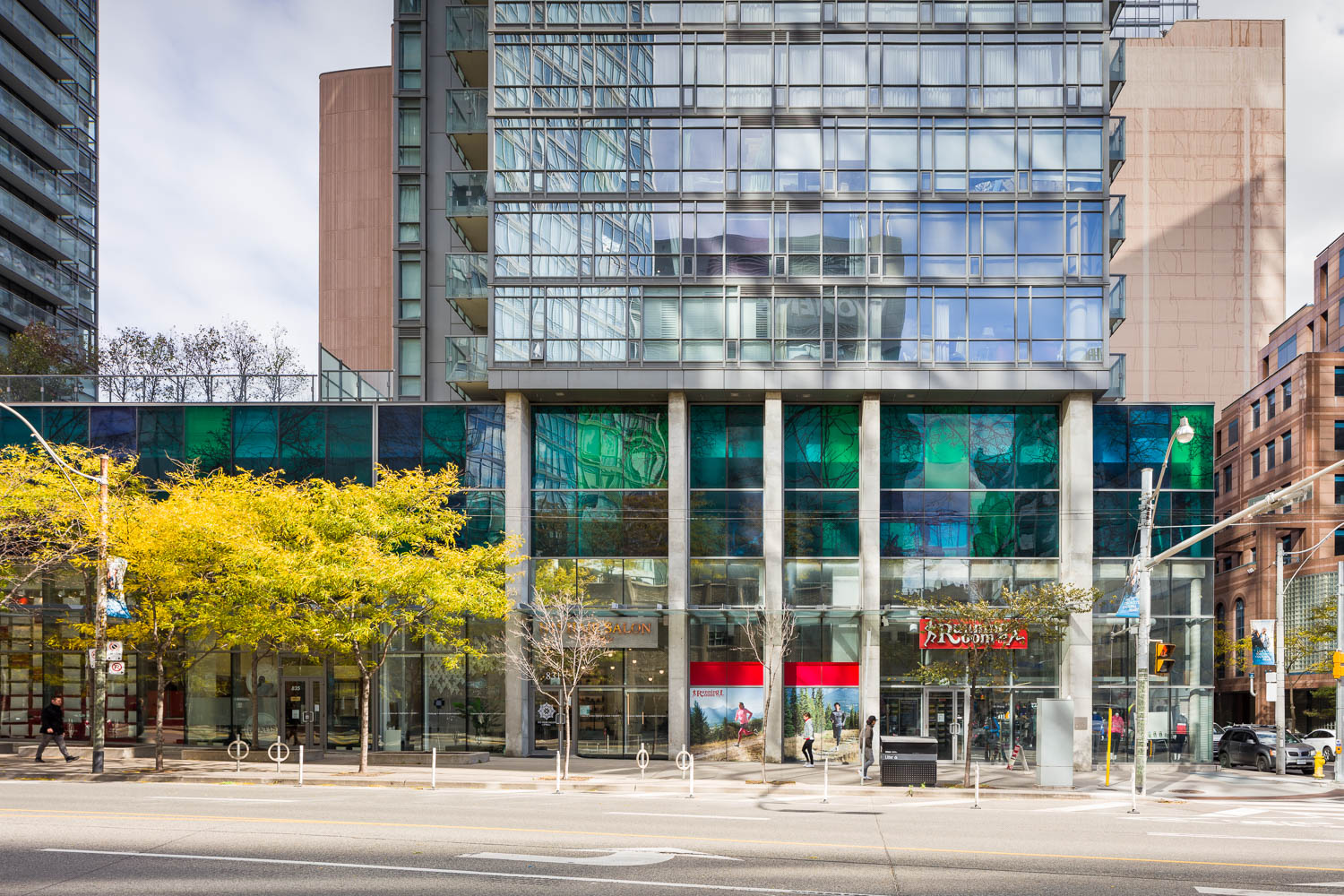
- Glass
- 2010
- 37 Grosvenor Street, Toronto
About the artwork
About the artist
For over four decades, Barbara Astman has explored a wide range of photo-based media and produced work, which has received national and international recognition.
She is represented in important public, corporate, and private collections, including the National Gallery of Canada, Ottawa, the Bibliothèque Nationale, Paris, Art Gallery of Ontario, Toronto, Deutche Bank, New York, and the Victoria and Albert Museum, London. Her artist’s archives are held in the E.P. Taylor Research Library & Archives, AGO.
Astman has been included in major group exhibitions, such as: Toronto: Tributes + Tributaries, 1971-1989 (AGO, 2016), Living Building Thinking: Art and Expressionism (McMaster Museum of Art, 2016), Look Again: Colour Xerography Art Meets Technology (AGO, 2015), Herland, (60 Wall Gallery, New York 2014), Light My Fire Part I: Some Propositions about Portraits and Photography (AGO, 2013), and Beautiful Fictions (AGO, 2009), among many others. Astman was commissioned to create a photographic installation (The Fossil Book) for the inaugural exhibition at the new Koffler Gallery (Toronto, 2013).
Astman has degrees from the Rochester Institute of Technology, School for American Craftsmen, and Ontario College of Art. She has also been a professor at OCAD University since 2001.
Fun facts
- As well as being an internationally recognized artist, Barbara Astman feels proudly Canadian and dreams to integrate one of her public artworks on the shores of Lake Ontario.
Engagement questions
- How can public art reactivate a space and make it special? What’s role does public art play in bringing communities together?
- How can artworks create a bridge between private spaces and the public realm to make Toronto’s streets friendlier?
Concrete Indians
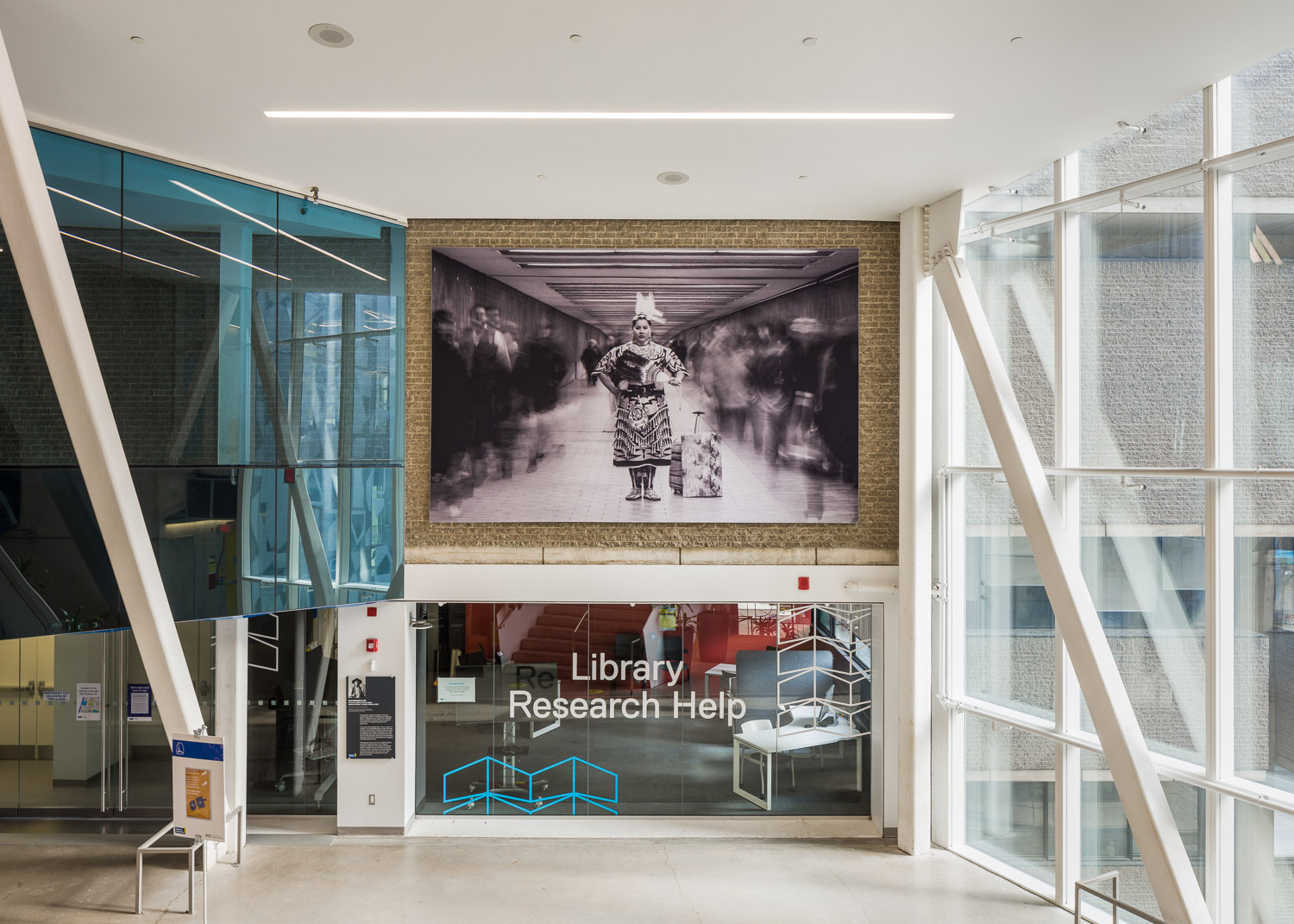
- Photography
- 2020
- 21 Gerrard Street East, Toronto
About the artwork
The mural, displayed at the Ryerson Library entrance, is a photograph by Nadya Kwandibens which features traditional dancer Tee Lyn Duke. Both women are Anishinaabe from Treaty 3 territory.
Shot by Kwandibens in 2010, the black-and-white portrait shows Duke standing firm in traditional regalia as ghostly rush-hour commuters whiz by in the long pedestrian tunnel connecting subway lines at Spadina station.
The image is from Kwandibens’ portrait series Concrete Indians, which explores the ways urban spaces affect Indigenous identity. Through this series, Kwandibens said she aims to portray visibility for other Indigenous people and in doing so, explores concepts of decolonization.
The 10 x 15.7-foot portrait is on display for five years.
About the artist
Nadya Kwandibens is Anishinaabe (Ojibwe) from the Animakee Wa Zhing #37 First Nation in northwestern Ontario. She is a self-taught portrait and events photographer. In 2008 she founded Red Works Photography. Red Works is a dynamic photography studio empowering contemporary Indigenous lifestyles and cultures through photographic essays, features, and portraits.
Nadya’s artistic practice builds upon three ongoing bodies of work: Concrete Indians is an open-call series of contemporary urban Indigenous identity and a collective representation of decolonial assertions of resistance and resurgence; Red Works Outtakes is an uplifting portraiture series created to combat the “stoic Indian” stereotype; and emergence, another open-call series, focuses on resurgent acts of decolonization by means of transmission and the conveyance of Indigenous intelligence.
Nadya is also a member of the Indigenous Laws + The Arts Collective, the founding body of Testify, a travelling multimedia group exhibition. Testify pairs artists and legal thinkers to work in conversation with each other to create art pieces that explore facets of Indigenous law.
In addition to commissioned works, Nadya delivers empowering photography workshops and presentations for youth, universities, and community groups.
Fun facts
- Tee Lyn Duke, the subject of the photo, is a jingle dancer and regularly rides Toronto transit wearing her traditional regalia, called the jingle dress or the healing dress. By wearing her regalia in urban spaces like public transit, Duke aims to challenge harmful narratives surrounding Indigenous people in Canada.
Engagement questions
- How does this piece make you feel?
- Does this piece make you rethink the narrative that Indigenous people don’t live in Toronto?
Untitled
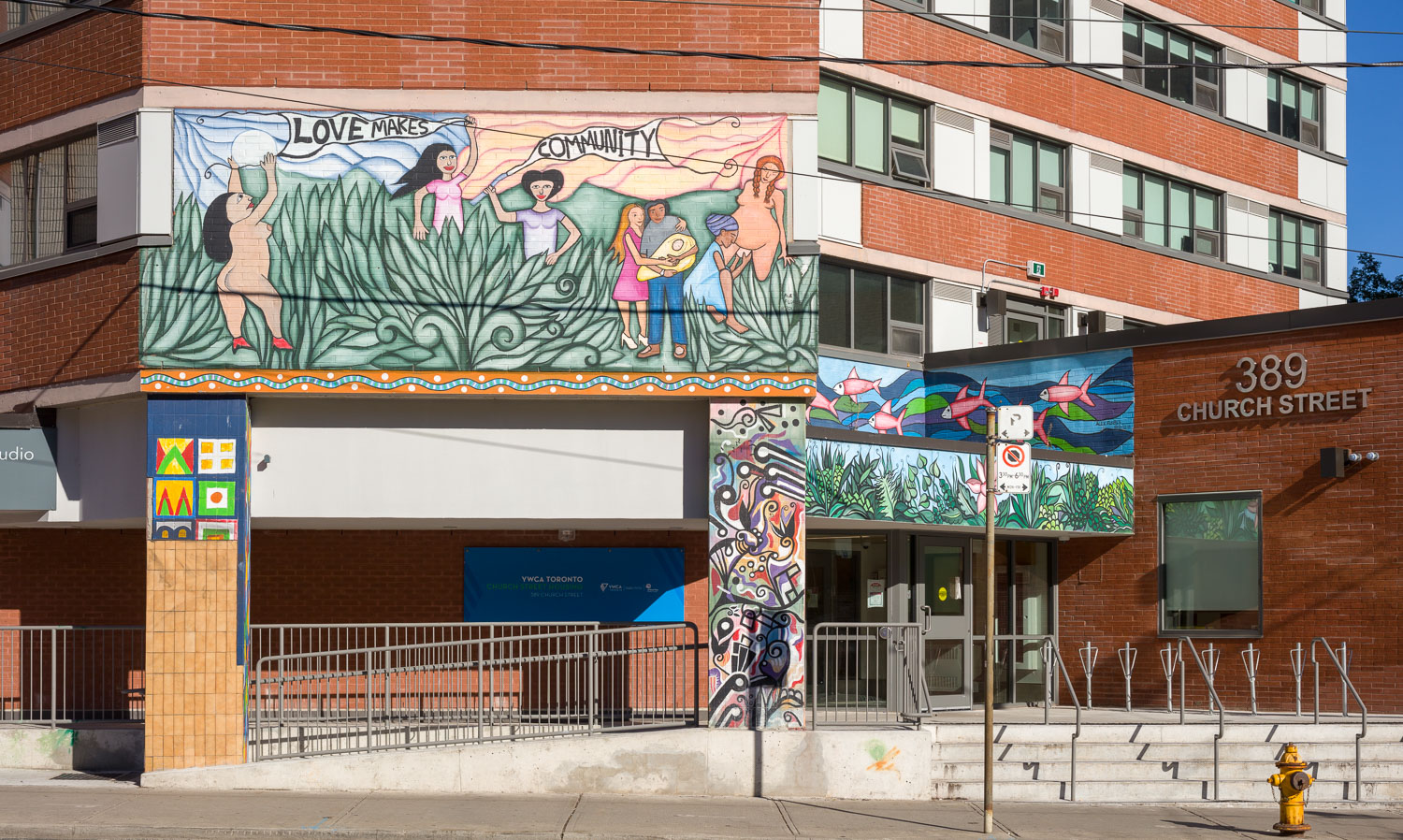
- Latex Paint
- 2013
- 389 Church Street, Toronto
About the artwork
This bright and colourful mural celebrates women throughout the world. Part of The Church Street Mural Project, the mural project sprang out of a desire to spruce up the neighbourhood and leave a lasting legacy for WorldPride festivities.
Project curator Syrus Marcus Ware says there was a lot of interest from artists to get involved with the project, which allowed the selection committee to choose projects that reflected the community.
About the artist
Alex Flores is the founder and Artistic Director of Las Perlas Del Mar Productions Inc. Flores has extensive mural and multimedia production experience, including ten years of experience as an independent filmmaker, using documentary video production and web design. He has been a visual artist for 18 years.
Artist Statement:
“When I create a painting, my energy becomes happy and positive. Through meditation, I dream I am in forests full of trees, with people and animals in different colours, the shapes become houses where all human beings live in harmony, surrounded by the beauty of the earth.
My paintings are like big urban cities or the jungle in spring, or like people gathering on a cold winter night. I paint my hometown in Mexico City mixing ideas with my home in Toronto.
My mind flies away onto the white canvas with ideas of colourful buildings, faces, trees, pets and harmony around all humans.
I want to show my vision about living in a safe world, where justice and peace and love come together.
The different shapes and structures in my paintings may seem surrealistic; this is an aspect of my technique that I love. I like people to think about what they see in my artwork.”
Fun facts
- As well as being a muralist and artist, Alex Flores has extensive experiences in multimedia production, even creating her personal online video platform to promote culture, politics and reflecting on the Latin community in Toronto and Canada.
Engagement questions
- Do you think Toronto needs more colourful artworks for its public realm?
- Why is this mural important for the community? And for women around the world?
Flow Blue
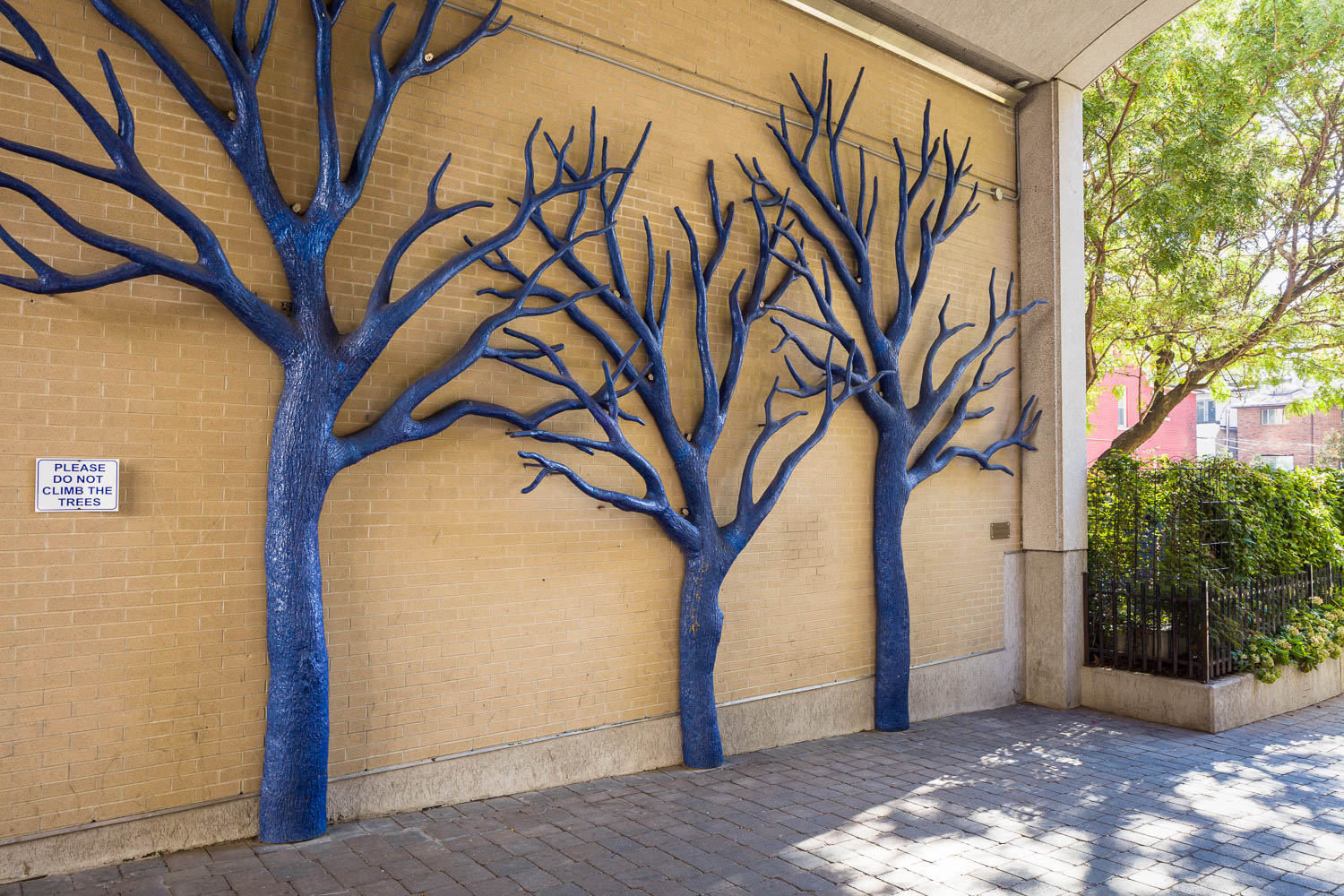
- Stainless Steel, LED Lights, Resin
- 2008
- Carlton and Granby Streets, Toronto
About the artwork
Flow Blue is a Toronto Public Art Commission for Edilcan Corporation, sited on Carlton and Granby Streets in Toronto. The tree motif was inspired by the historic tree-lined Granby Street that forms part of this site.
An avenue of trees, seventeen feet in height, lines an Archway that joins Granby to Carlton. This avenue of trees accentuates the historic use of the path through the Archway, yet emphasizes the urban context by replacing the natural tree colour with electric-blue auto body paint. By night the vault of the Archway is illuminated with blue LED lights, simulating the sky.
Three hundred feet of stainless steel fence system, laser-cut in a flowing tree-branch design, lines the gentrified townhouses of the Granby Street area. Blue LED lights illuminate this fence at night, continuing the flow of blue and accentuating the tree-branch design.
About the artist
Marlene Hilton-Moore is a self-taught artist born in New Brunswick and living in Ontario. Her work is in numerous collections, including the Canada Council for the Arts’ Art Bank and the Wilfrid Laurier University collection. She has also produced a number of works of public art, including Monument aux Valeureux in Ottawa and Column of Valour, a monument dedicated to volunteer firefighters in Barrie, Ontario.
Fun facts
- The tree motif was inspired by the historic tree-lined Granby Street that forms part of this site.
Engagement questions
- Can art replace the beauty of nature?
- How do you feel when you see trees made out of steel?
Several Photographs by the winners of the New Generation Photography Award
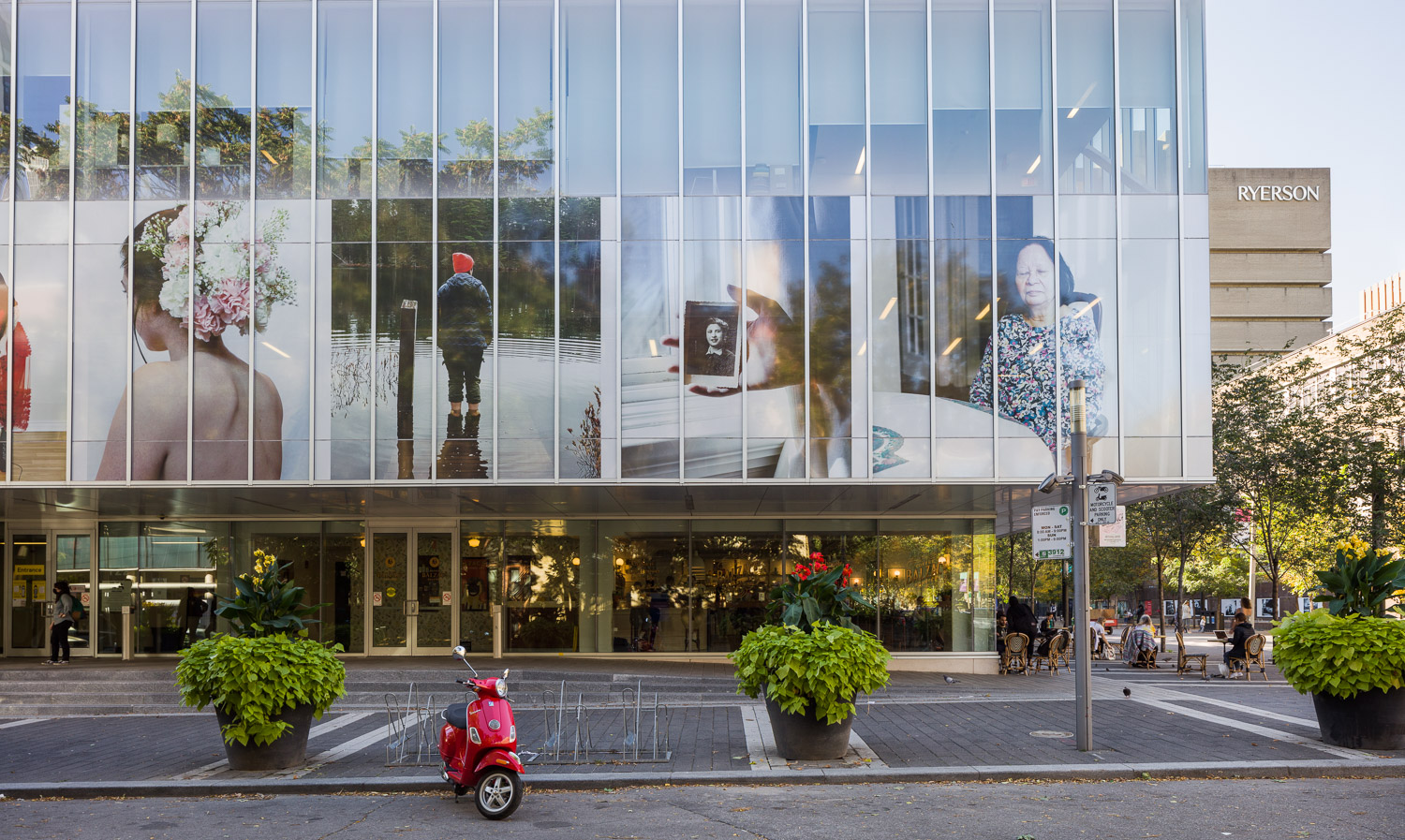
- Photography
- 2017, 2019
- Inside the courtyard, Gould Street, multiple locations, Toronto
About the artwork
The New Generation Photography Award recognizes the practices of some of Canada’s most promising lens-based artists.
Reflecting the expressive power of photography, the images in this exhibition provide a compelling overview of this moment in time. Whether exploring the impact of industry and poverty, issues affecting Black and Indigenous Peoples, the built and natural world, or the minutiae of everyday life, each photographer has also used the medium as a conceptual tool, encouraging viewer engagement with the preoccupations of today’s world.
About the artist
THE 2020 WINNERS
Toronto-born Curtiss Randolph constructs scenes as either tableau or staged documentary narratives. Having grown up in a theatre family, the elements of stage production crept into his working process at an early stage. Mixing realism, surrealism, and gonzo journalism, Randolph challenges viewers’ preconceived notion of documentary-style as a way to question ideas of fact and fiction in the photographic medium.
Katherine Takpannie is an Ottawa-based Inuk artist, writer and graduate of the Nunavut Sivuniksavut (NS) program. Her photographs set performative and political gestures against both natural and built environments, including intimate portraits of women. Her work is held in the City of Ottawa’s art collection and has appeared in Getting Under Our Skin exhibition at the Art Gallery of Guelph and They Forgot We Were Seeds exhibition at the Carleton
University Art Gallery.
Vancouver/Berlin-based Noah Friebel focuses on the fabricated aspect of the photograph, using elements of sculpture and installation to examine our relationship to images, each other, and the narrowing space in between. Since graduating from Emily Carr University with a BFA in 2018, Friebel has been part of several group shows: notably Green Glass Door at Trapp Projects and The Lind Prize 2018 at Polygon Gallery.
THE 2021 WINNERS
Chris Donovan is a lens-based artist working in Toronto and New Brunswick. Hailing from the industrial city of Saint John, his practice focuses on the intersection of community and industry. His work has been awarded by Pictures of the Year International (U of Missouri), The Alexia Foundation (Syracuse University), The New Brunswick Arts Board, The Toronto Arts Council, and exhibited across Canada at photography festivals including CONTACT (Toronto), Capture (Vancouver), Exposure (Calgary), Flash (Winnipeg), and Zoom (Saguenay). He is a member of the Boreal Collective and currently pursuing an MFA in Documentary Media at Ryerson University as a Graduate Fellow.
Toronto-based artist Dainesha Nugent-Palache has participated in numerous exhibitions nationally and internationally. A founding member of the plumb, an ad hoc collective of artists, writers and curators and art venue in Toronto, she has also curated for the feminist music festival and concert series Venus Fest, and Blindspots, an art exhibition and film screening where queer artists explore LGBTQ experience through a diasporic lens. Graduate and recipient of major awards, her artwork is found in The Wedge Collection, Toronto Dominion Bank Art Collection and private collections. Her experiences as an artist have also been spotlighted in CBC COVID residencies series.
Vancouver-based artist Dustin Brons MFA (UC San Diego), BFA (UBC), and recent participant in the Whitney Independent Study Program works with the recontextualization of existing materials across photographs, videos, and text. His work incorporates visual forms from Western art history as tools to process contemporary sources. Still life and landscape painting, gestural abstraction, linguistic conceptualism, and photographic devices from pictorialism to appropriation are re-configured in representations of climate change and gentrification, emphasizing the ways that visual forms contribute to shaping social and political understandings of these intangible yet totalizing processes.
Fun facts
- Donovan’s series of photos, entitled Cloud Factory, originated when he worked at a newspaper office located across from a pollution-spewing oil refinery.
- Brons seems to find beauty in every objects, including a yet ordinary “pot of soup”.
Engagement questions
- Does art have limits in terms of aesthetic?
- Do you believe creative endeavour can deter the strict boundaries of the art world?
Imagine Together
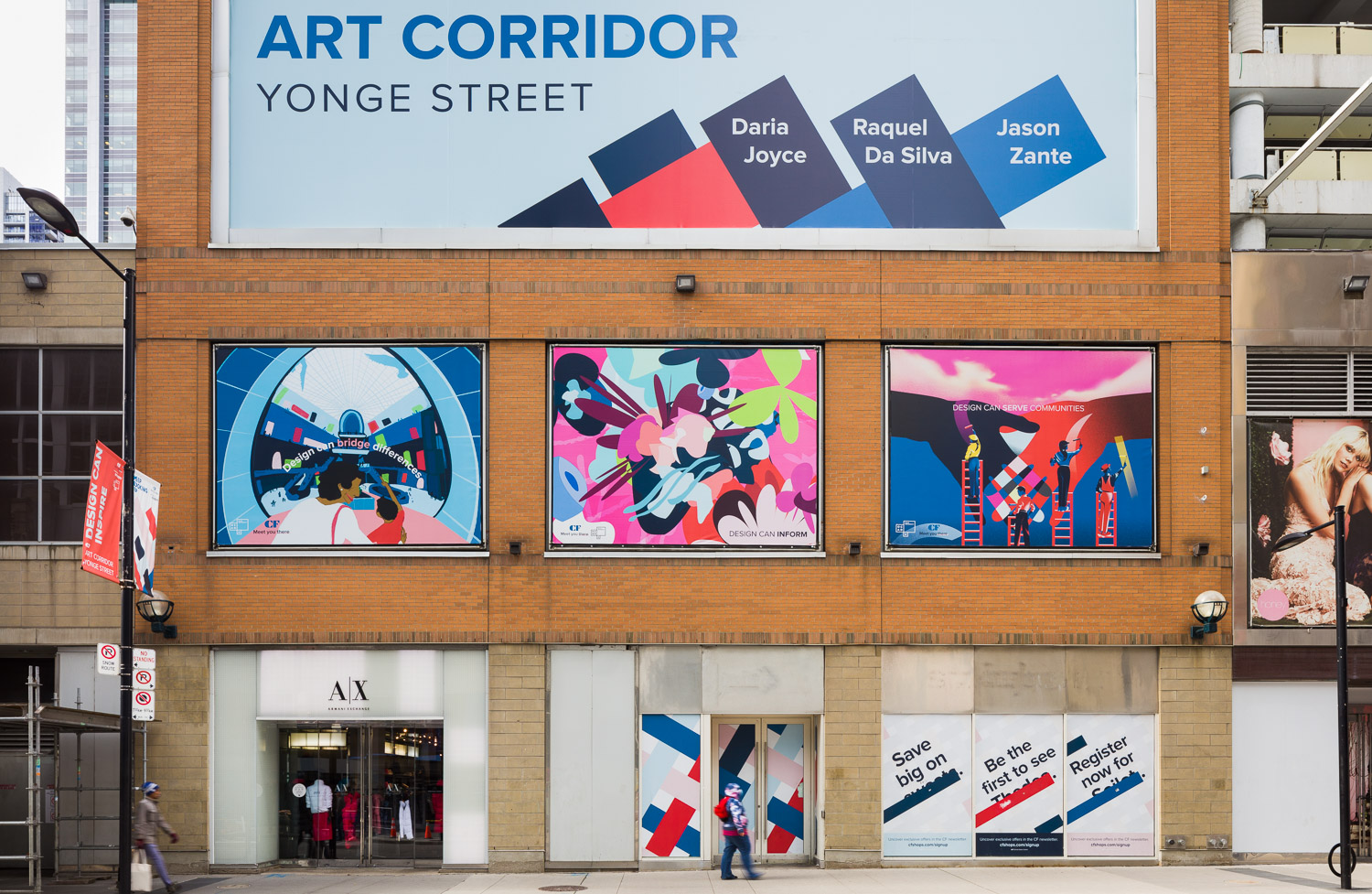
- Spray Paint
- 2021
- 220 Yonge Street, Toronto
About the artwork
Many of us missed human connection during the lockdown. All the time of social distancing made us realize that we truly need each other in many ways. Community is at the heart of what keeps us together. Where we live, work and play. With that in mind, Cadillac Fairview (CF) in collaboration with OCAD University has unveiled an inspiring new space for local creatives — the CF Toronto Eaton Centre Art Corridor.
Visitors of the popular local and tourist destination can find a portion of Yonge Street from Dundas to Queen transformed into a beautiful outdoor digital gallery located above the iconic shopping centre. The exhibition titled Imagine Together features original works by emerging OCAD University artists in an 18-month long exhibition. A total of nine inspiring works will be featured in the massive exhibit in alignment with CF’s overall commitment of Transforming Communities for a Vibrant Tomorrow.
The original call for submission asked OCAD University’s Faculty of Design graduates to consider how art can bring people together and build community. Each artist was asked to reflect on their personal experiences about what it means to be inclusive, together and socially connected. Within their designs the artists were asked to consider physical, emotional and sensory elements to nurture community and empower individuals.
Toronto-based artists Raquel Da Silva, Jason Zante, and Daria Joyce will be featured during this incredible exhibition.
About the artist
Working primarily in paint and sculpture, artist Raquel Da Silva focuses on creating abstract environments. Currently her work explores how two and three-dimensional forms and shapes can work together to create an environment. Her art in this collaboration celebrates the vibrant culture of our city. She reflects on that energy to inform, inspire, and regenerate. Da Silva recently completed a one-year residency at the Museum of Contemporary Art in Toronto.
Filipino-Canadian multidisciplinary artist, Jason Zante, has already gained a huge fanbase in the art scene. He’s known for his use of vibrant colours, bold contrasts and ethereal landscapes in his art. If his style looks familiar you may have recently passed by his larger than life mural titled The Riviera located at the Four Seasons Hotel Toronto. His work has also been featured in Architectural Digest.
Illustrator Daria Joyce‘s playful and vibrant style reflects the power of connection at one of North America’s largest shopping destinations located right here in the heart of our city. Her work depicts the inspiring environment bringing people together into the communal experience beyond retail activity.
Fun facts
- This is the first time these billboards are being used for community artwork rather than advertising.
Engagement questions
- Do you think the public realm should be less about advertising campaigns and more about public art?
- Do you believe in the power of art as a useful tool to reach out to communities?
Safe Water
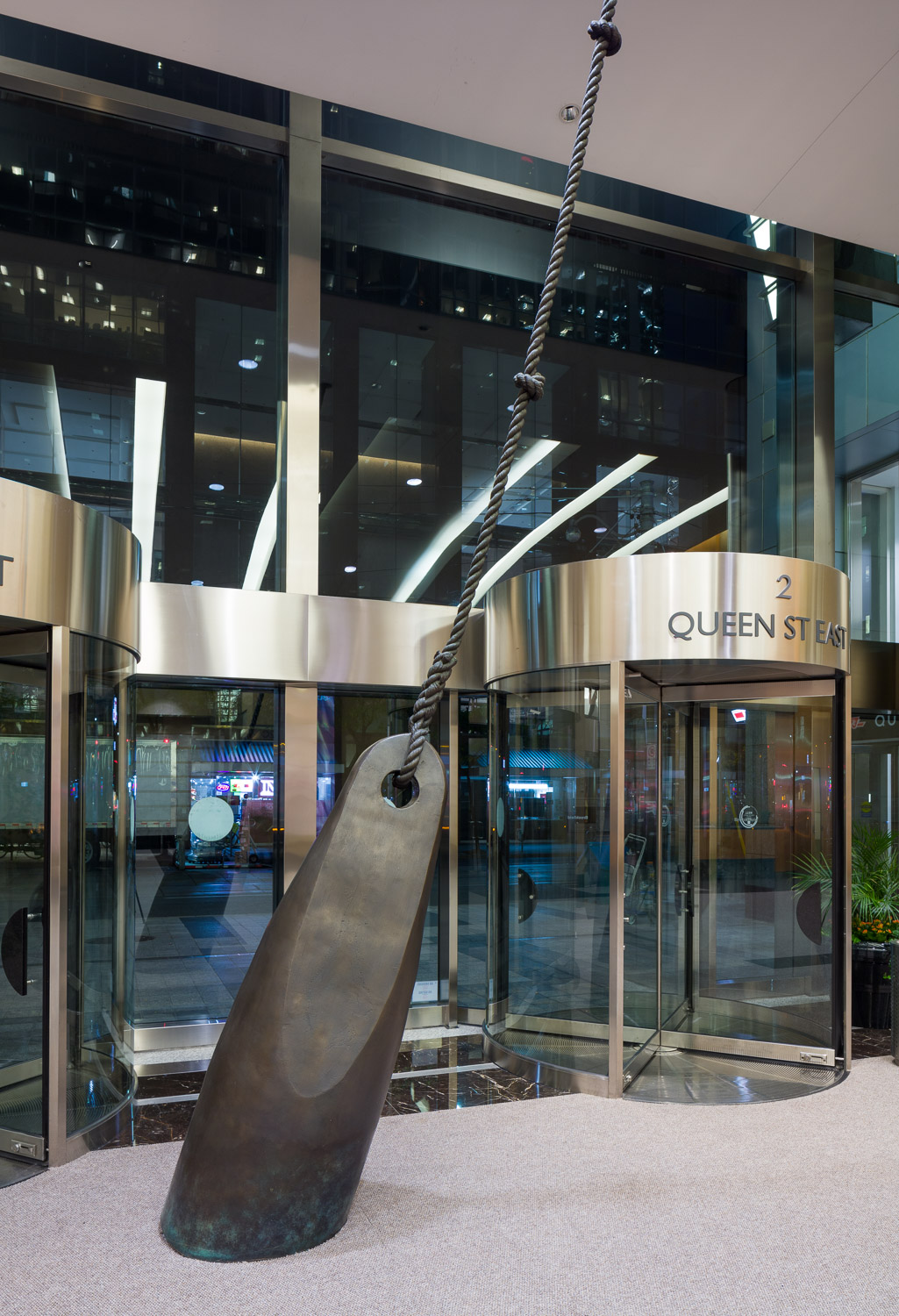
- Steel
- 2002
- 2 Queen Street East, Toronto
About the artwork
The lead line is a weighted rope, knotted or marked, used by seamen to measure the depth of the water. Historically, safe water, or “Mark Twain”, was two fathorns. We have implied by the knotted rope and the modification in scale that this site marks “safe water”.
About the artist
In 1972, Colette Whiten graduated from the Ontario College of Art and Design, receiving the Governor General’s Medal in recognition of her fine work. In the same year, she exhibited her first cast piece: a wooden structure filled with fibreglass molds of her friends’ arms and legs. Whiten’s figures express the nature of human existence and are primarily concerned with human interaction, particularly power relationships. The artist is also fascinated with the process of art, often documenting her creative flow through photographs and slides.
Over the years, the focus of Whiten’s practice and subject matter has evolved to include explorations into identity and the duality inherent in cast images, the nature of the art object and art making, and political power or everyday violence. Whiten’s larger scale, sculptural pieces have taken years to make as their many intricate pieces are constructed mainly by hand.
Whiten’s public art commissions include a wall construction with figurative cutouts for the Mental Health Centre, Toronto (1978), an award-winning sculpture for the 1988 Calgary Olympics, Weathervanes for Bankers Hall, Calgary (1990-91), and Tender, at the Worker’s Compensation Office, Simcoe Place, Toronto (1994-95.) Both Weathervanes and Tender were collaborations with Paul Kipps, Whiten’s beloved partner.
Between teaching at York University and the Ontario College of Art and Design, Whiten’s work has been featured in both solo and group exhibitions around the world. In 1991, she was the recipient of the Toronto Arts Foundation’s Visual Arts Award and in 2013, she was awarded a Governor General’s Award in Visual and Media Arts.
Upon earning his BA in Visual Art from the University of Western Ontario, Paul Kipps focused his artistic practice in the realm of sculpture. His works were driven by his interest in alienation, shaped by the often exclusive nature of cultural backgrounds, age, gender, class, or place. Kipps explored these concerns through the making of sound, photography, and three-dimensional structures.
Kipps’ work was exhibited in both Canada and Europe, and has been presented across Canada through a number of collaborative public art commissions with his partner, Colette Whiten. Kipps taught for many years, offered his distinct eye in curating, and continued to create up until his death in 2014.
Fun facts
- For an exhibition with Whiten called Over Taking Over, Paul Kipps brought his concept of a "garden of sound" to life. As a way of coping with his widowed mother's dementia, Kipps began documenting the impact of her condition on his own life, creating soundtracks out of her garbled phone calls and pairing them with sixteen gramophone-like wooden cones.
Engagement questions
- How does this work interact with the environment around it? Does the space amplify or benefit the artwork?
The History of Theatre on Yonge Street
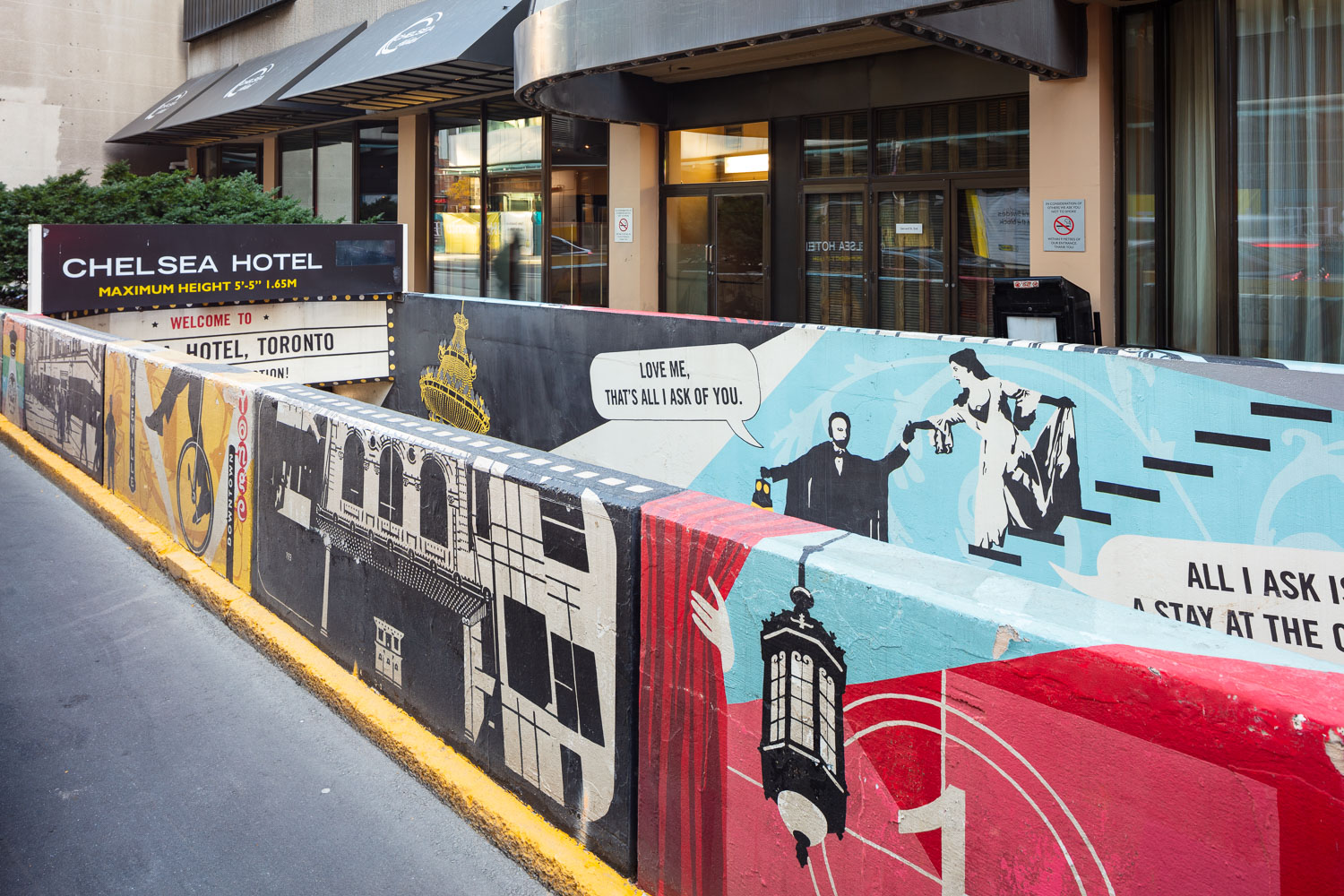
- Spray Painting
- 2018
- 33 Gerrard Street West, Toronto
About the artwork
In collaboration with the Chelsea Hotel and Downtown Yonge BIA, this mural showcases Yonge Street’s theatre scene over the past century. The wall stretches 145-feet long with images of theatres, props and actors depicted in horizontal panels to look like a film strip. Life-size patrons and children line the pedestrian sidewalk, while vintage cars are painted on the street side.
Four panels include realistic facades of four different theatres that were painted in black and white to give a timeless feel and add to the historical theme. Colourful beams of light tie the entire mural together as they illuminate from old projectors, stage lights and headlights. The inside of the ramp includes the familiar underground scene from the Phantom of the Opera. A painted marquee welcomes guests as though they’re entering a theatre. “Park. Check-in. Action!”
About the artist
Pam Lostracco is recognized as an award-winning graphic designer and artist. While studying at OCAD, she completed an exchange in Scotland, won a group competition and earned two scholarships—including her name on a plaque at The Arts and Letters Club.
Pam has worked for several Toronto design studios, including Dinnick & Howells and Viva Dolan. While working with the best art directors, she produced high-end books and identities for clients including Butterfield & Robinson, Curious Papers and Ace Bakery. These projects earned awards from the Advertising & Design Club of Canada, Applied Arts, and Communication Arts. Her illustrations have also been printed in books for Jump Math and Fisher Price, and she continues to design books and logos.
A year-long travel endeavour, started a new artistic path of making mixed-media artwork. Her drawings and photographs were layered into a unique style that has been exhibited at the McMichael, Toronto Outdoor Art Exhibition and Toronto Pearson International Airport. She has collaborated with public art projects, including a bench design for Liberty Village, photographs presented in TTC stations for the Contact Photography Festival, and a traffic lightbox for the city’s Outside the Box program. Pam’s artwork and products have been purchased by the Four Seasons Hotel, Craft Ontario and The Textile Museum of Canada.
Now, Pam is designing and painting walls for homes, condos, shops and resorts around Canada. Her murals have been featured on Apartment Therapy and Pinterest. Pam’s goals are working towards helping to improve communities and health care facilities around the world. She continues to draw nature and explore places, while at the same time, create beautiful and uplifting spaces.
Fun facts
- This mural showcases the history of theatre on Yonge Street and reminisces on the hotel’s involvement as the go-to entertainment hotel, bringing to life theatre within the street.
Engagement questions
- How can public art bring to life the old hidden story of an entire neighbourhood?
- Can public art help bridge the gap between diverse forms of art for the community?
To Serve and Protect
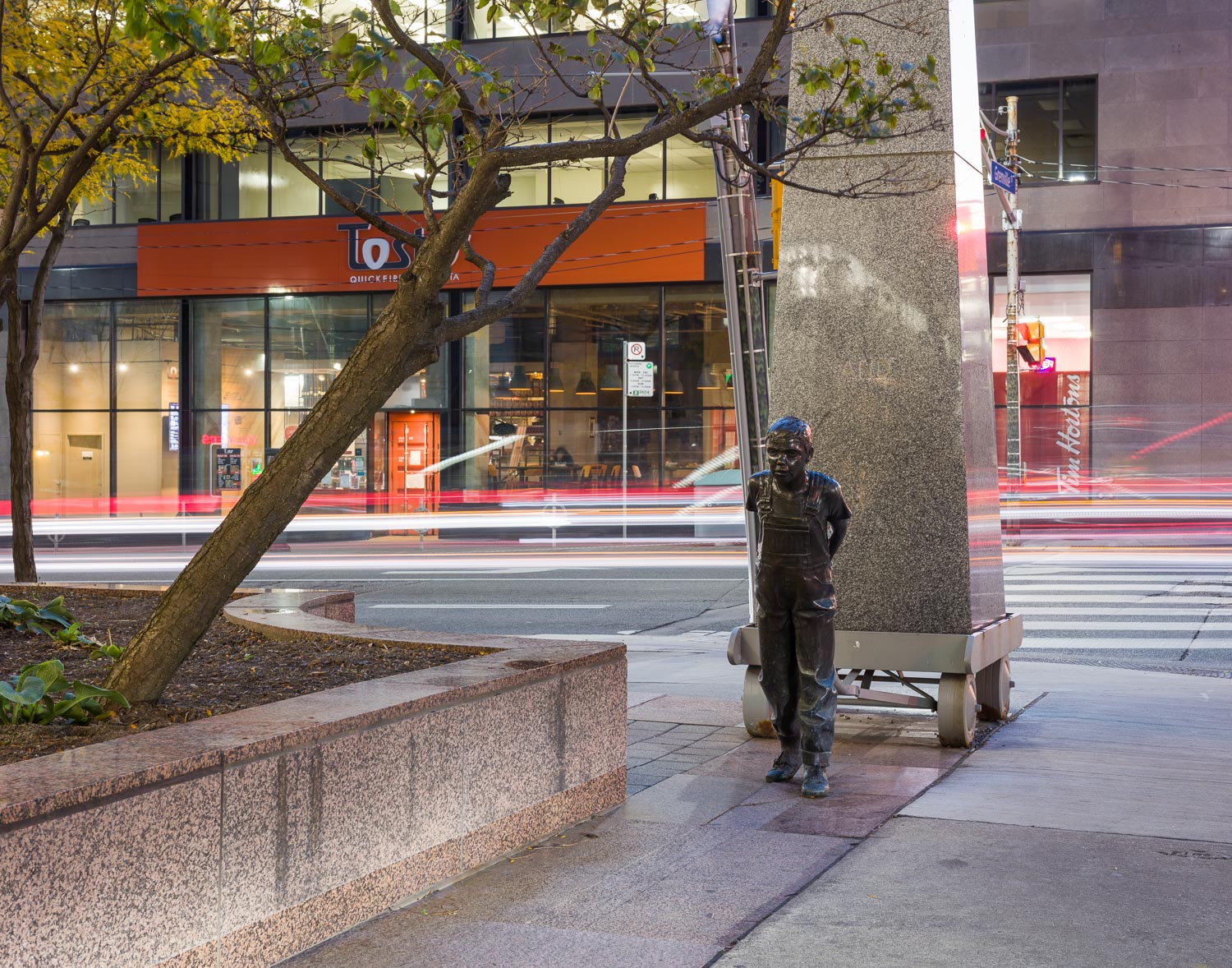
- Bronze, masonry, painted steel
- 1988
- 40 College Street, Toronto
About the artwork
This sculpture is an allegorical trinity of elements in three distinct sites of the Police Headquarters building in downtown Toronto. The three elements may stand alone but together they form a unified narrative. There are three life-size realistically rendered figures performing three actions.
In the central square of the building is a policewoman, police radio in one hand, a trowel in the other constructed a stone base. At the northwest corner of the building is the rendering of a child pulling an oversized child’s wagon. An obelisk sits on the wagon. The wagon is constructed of metal with a two-inch-thick base plate on which the obelisk floats.
At a side entrance, walking into the building is a male figure carrying a primitive support on which are balanced two books and two stone blocks on his shoulders.
About the artist
Eldon Garnet is a multidisciplinary artist and writer based in Toronto. Surveys of his sculptures and photographic work have been held at the National Gallery of Canada, the Museum of Contemporary Canadian Art and the Amsterdam Center of Photography. He is represented by the Christopher Cutts Gallery in Toronto and Torch Gallery in Amsterdam. Garnet is also a professor at the Ontario College of Art and Design University.
Constructing an unsettling ambiguity by using whatever means of expression Garnet deems suitable is probably the only connecting thread in his works. Instead of defining himself as an artist with a central medium, he tries to create an allegory of words, images, sound and time.
His projects often take on the qualities of a contemporary gesamtkunstwerk (the German term “Gesamtkunstwerk”, roughly translates as a “total work of art” and describes an artwork, design, or creative process where different art forms are combined to create a single cohesive whole) that surpasses both the obvious narrative and the postmodern ironic.
He uses tools like humour, erotic triggers and commonplace semiotic patterns, but never lets them reach their perceived conclusion. The effect is best described as a recognition of the joke but never getting to the punchline, or feeling disgusted or aroused but never quite understanding why.
Fun facts
- The obelisk is polished Canadian granite 21 feet high, 3 foot square at the base.
Engagement questions
- How does this work make you feel?
- How do you engage with the subject of the work?
Curtain, NXNE Festival
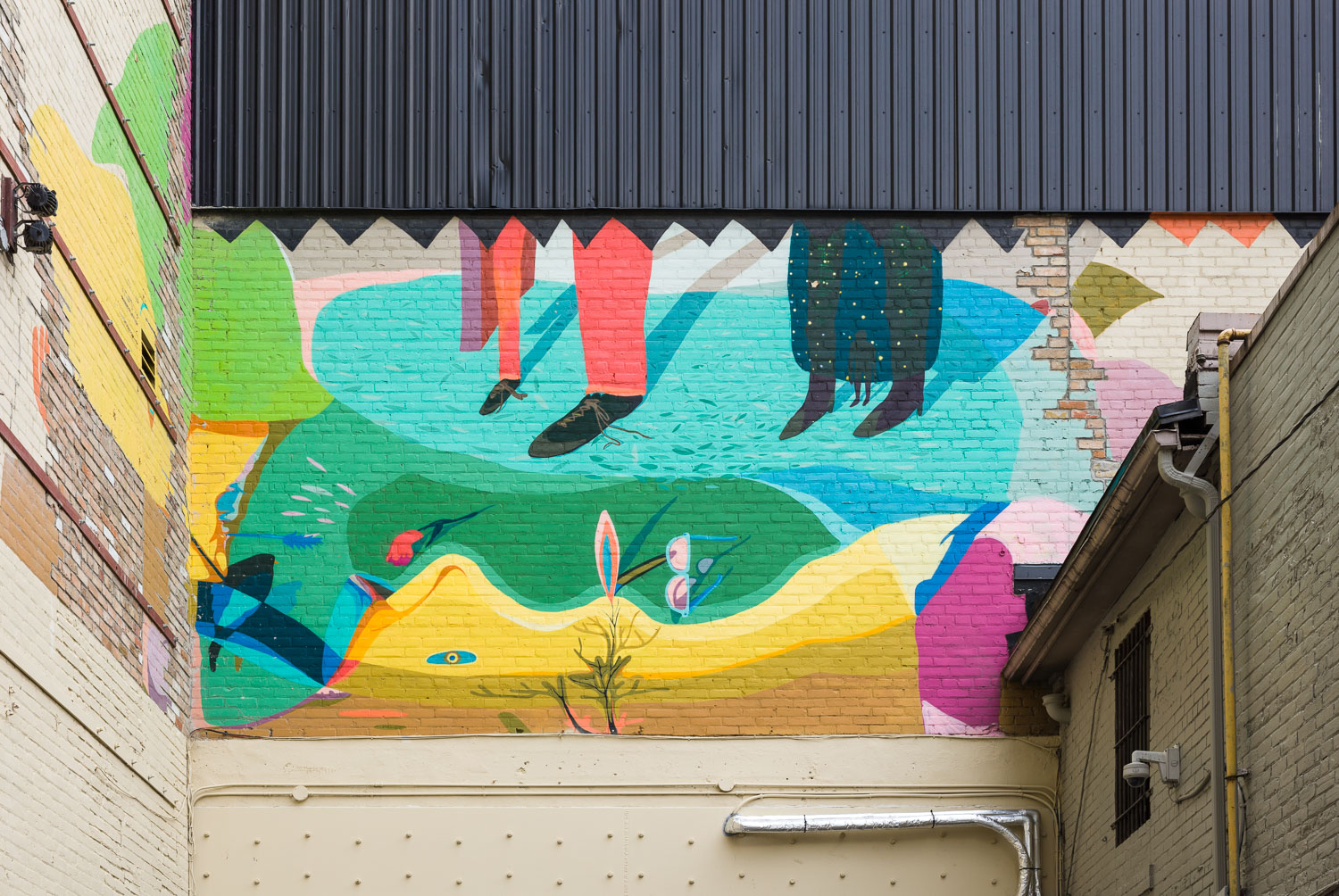
- Latex and spray paint
- 2014
- O’Keefe Lane South (Mirvish Theatre), Toronto
About the artwork
The mural, in collaboration with Downtown Yonge BIA, took inspiration from the Mirvish theatre setting, now stands as a vibrant icon and a catalyst, not only for a greater focus on laneway revitalization, but also for stronger community collaborations.
The abstract and colourful shapes invite the public to walk through the street and come to admire the hidden gems of Toronto’s urban realm. While visitors will mainly refer to the bright colours of the mural, the artwork also depicts different human shapes, yet not seeing their faces, perhaps a metaphor of our urban living.
About the artist
PA System’s Alexa Hatanaka and Patrick Thompson work in textile, printmaking, painting, video, and public art. They create collaborative and socially-engaged projects namely in the high arctic, including their ongoing project with Inuit youth in Kinngait (Cape Dorset, Nunavut) called Embassy of Imagination.
Their work has been exhibited in institutions worldwide, such as the Royal Ontario Museum, The Art Gallery of Ontario, Centre de Cultura Contemporània de Barcelona, University of New Mexico Art Gallery, Canada House in London and the Guanlan International Printmaking Base in China. In September of 2019 they exhibited their work in the inaugural Toronto Biennial of Art.
PA System has been involved in the Kinngait community for six years spending three months at a time activating their Embassy of Imagination workshops or projects with the youth. They lead out-of-community projects with smaller groups of youth annually. Their work as PA System is currently informed by the significant time spent in Kinngait, as documentation of moments, memories and the land, and reflects on how they may address issues or aspirations identified by the youth, with the youth.
They have partnered with the District Education Authority of Kinngait to launch PPStudio (printmaking program) and Land and Cultural Leadership Program. Equipment funding for the latter program is received from the sales of the collaborative Future Snowmachines in Kinngait ongoing project. The Snowmachines have been exhibited in the AGO and as a large-scale installation at The Bentway.
Fun facts
- Downtown Yonge neighbourhood has more than 1.5 km of laneways which presents a challenge for the area and its community to revitalize Toronto’s streets.
Engagement questions
- Do you think art walks can be great tools for engagement processes?
- Would you like to be involved in more community-led creative projects?
The Ring
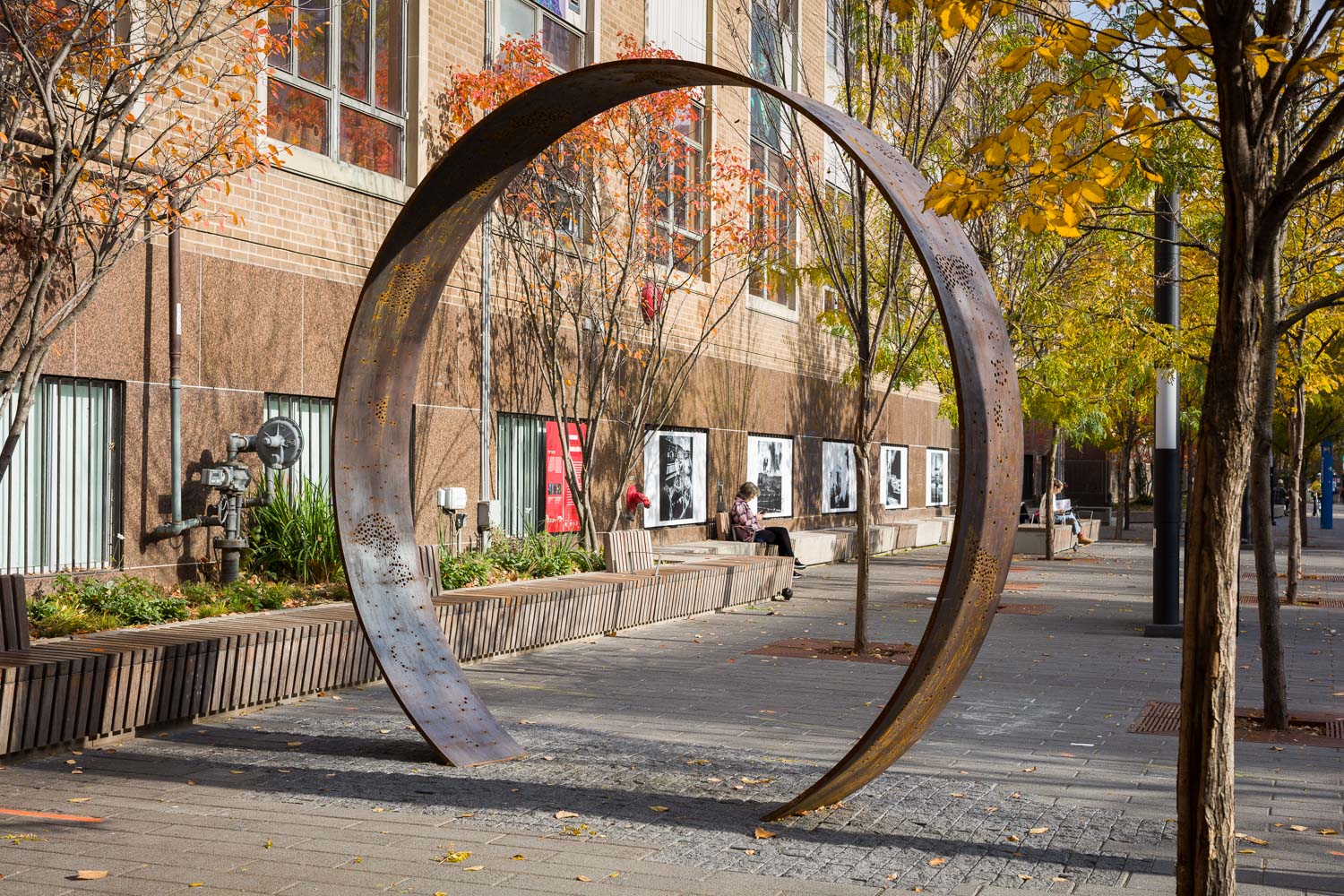
- Corten weathering steel
- 2021
- Ryerson University (east of the Gould Street and Nelson Mandela Walk intersection), Toronto
About the artwork
A large-scale public artwork colloquially known as The Ring was installed on campus in September 2021, honouring the Dish With One Spoon Territory, the land on which the university is built. Designed by Matthew Hickey and Jacqueline Daniel of Two Row Architect, the three-metre tall steel sculpture is located east of the Gould Street and Nelson Mandela Walk intersection.
The sculpture emerged from the thoughtful and ongoing work of the university’s Truth and Reconciliation Strategic Working Group in collaboration with members of Ryerson’s Indigenous community.
The Ring’s graphics, made by small perforations, incorporate the Seven Grandparent teachings and their animal symbols: Humility, Courage, Honesty, Wisdom, Truth, Respect and Love. Surrounded by stars and the constellation Pleiades, these pictographs also depict the lunar moon phases. The Ring is oriented with the cardinal directions (North, South, East and West) so that the pathway through its opening faces east, representing creation and new beginnings; and west, representing knowledge and wisdom.
Manufactured by Mariani Metal Fabricators, The Ring is made of Corten weathering steel, a type of material that is less processed and more likely to change with its environmental conditions; its exterior has been left untreated deliberately to allow the weathering process to continue.
The installation of such a prominent and permanent art piece on campus is one of many ways the university is working to implement recommendations from its 2018 Truth and Reconciliation Report, which includes the important practice of acknowledging the traditional territory and presence of Indigenous peoples on this land.
About the artist
Matthew Hickey is Mohawk from the Six Nations First Nation and is a licensed architect with 12 years of experience working in an on-reserve architecture firm. He received his Masters of Architecture from the University of Calgary and his Bachelor of Design from Ontario College of Art and Design, winning both the Alberta Association of Architects Presidents Medal and the Medal for Best Thesis, respectively.
Hickey’s focus is on regenerative design – encompassing ecological, cultural, and economic principles. His research includes Indigenous history and the adaptation of traditional sustainable technologies to the modern North American climate. He currently instructs at OCAD U, for the OAA and the Canada Green Building Council.
Jacqueline Daniel is an intern architect at Two Row Architect. She is a graduate of University of Michigan’s master of architecture program and holds a BA in architecture from the University of Toronto.
Two Row Architect is focused on guiding the realignment of mainstream ways of thinking on their journey towards Indigenous ways of knowing, being, design and architecture. The steel sculpture is one of a series of public art pieces at the university that will come to fruition throughout 2022.
Fun facts
- The story of The Ring was featured on Ryerson’s University’s The Forefront (season 2, episode 2), a podcast that showcases how Ryerson is tackling the big issues facing Canadians through bold research, innovation, and collaboration. The episode is called “How art can heal.”
- This year, the university is taking part in the City of Toronto Year of Public Art initiative, with a series of installments and exhibits. The Ring is one of the installments and is in honour of The Dish With One Spoon Territory, the land on which the university is built.
Engagement questions
- How can public artworks create a powerful dialogue towards the reconciliation process?
- How can art in the public realm best represent Indigenous communities and highlight their cultures and identities?
